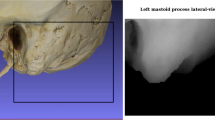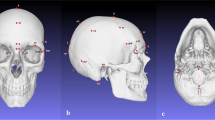Abstract
It is widely accepted that the estimation of biological attributes in the human skeleton is more accurate when population-specific standards are applied. With the shortage of such data for contemporary North African populations, it is duly required to establish population-specific standards. We present here the first craniometric standards for sex determination of a contemporary Tunisian population. The aim of this study was to analyze the correlation between sex and metric parameters of the skull in this population using CT scan analysis and to generate proper reliable standards for sex determination of a complete or fragmented skull. The study sample comprised cranial multislice computed tomography scans of 510 individuals equally distributed by sex. ASIRTM software in a General ElectricTM workstation was used to position 37 landmarks along the volume-rendered images and the multiplanar slices, defining 27 inter-landmark distances. Frontal and parietal bone thickness was also measured for each case. The data were analyzed using basic descriptive statistics and logistic regression with cross-validation of classification results. All of the measurements were sexually dimorphic with male values being higher than female values. A nine-variable model achieved the maximum classification accuracy of 90% with −2.9% sex bias and a six-variable model yielded 85.9% sexing accuracy with −0.97% sex bias. We conclude that the skull is highly dimorphic and represents a reliable bone for sex determination in contemporary Tunisian individuals.



Similar content being viewed by others
References
White TD, Black MT, Folkens PA (2012) Human Osteology. Elsevier, Paris
Işcan MY, Steyn M (2013) The human skeleton in forensic medicine. Charles C Thomas Publisher ltd. Springfield, Illinois
Işcan MY (2005) Forensic anthropology of sex and body size. Forensic Sci Int 147:107–112
Scheuer L (2002) Application of osteology to forensic medicine. Clin Anat 15:297–312
Stojanowski CM, Seidemann RM, Doran GH (2002) Differential skeletal preservation at Windover Pond: causes and consequences. Am J Phys Anthropol 119:15–26
Walker P (1995) Problems of preservation and sexism in sexing: some lessons from historical collections for palaeodemographers. In: Saunders SR, Herring A (eds) Grave reflections portraying the past through cemetery studies. Canadian Scholaris Press Inc., Toronto 18:31–48
Guyomarc’h P, Dutailly B, Charton J et al (2014) Anthropological facial approximation in three dimensions (AFA3D): computer-assisted estimation of the facial morphology using geometric morphometrics. J Forensic Sci 59:1502–1516
Giles E, Elliot O (1963) Sex determination by discriminant function analysis of crania. Am J Phys Anthropol 21:53–68
Franklin D, Cardini A, Flavel A, Kuliukas A (2013) Estimation of sex from cranial measurements in a Western Australian population. Forensic Sci Int 229:158.e1–158.e8
Ogawa Y, Imaizumi K, Miyasaka S, Yoshino M (2013) Discriminant functions for sex estimation of modern Japanese skulls. J Forensic Legal Med 20:234–238
Dirkmaat DC, Cabo LL, Ousley SD, Symes SA (2008) New perspectives in forensic anthropology. Am J Phys Anthropol (suppl 47):33–52
Guyomarc’h P, Bruzek J (2011) Accuracy and reliability in sex determination from skulls: a comparison of Fordisc 3.0 and the discriminant function analysis. Forensic Sci Int 208:30–35
Bidmos MA, Dayal MR (2004) Further evidence to show population specificity of discriminant function equations for sex determination using the talus of South African blacks. J Forensic Sci 49:1165–1170
Weisensee KE, Jantz RL (2011) Secular changes in craniofacial morphology of the Portuguese using geometric morphometrics. Am J Phys Anthropol 145:548–559
Spradley MK, Jantz RL, Robinson A, Peccerelli F (2008) Demographic change and forensic identification: problems in metric identification of Hispanic skeletons. J Forensic Sci 53:21–28
Ramsthaler F, Kreutz K, Verhoff MA (2007) Accuracy of metric sex analysis of skeletal remains using Fordisc based on a recent skull collection. Int J Legal Med 121:477–482
Franklin D, Cardini A, Flavel A et al (2013) Concordance of traditional osteometric and volume-rendered MSCT inter-landmark cranial measurements. Int J Legal Med 127:505–520
Verhoff MA, Ramsthaler F, Krähahn J et al (2008) Digital forensic osteology—possibilities in cooperation with the Virtopsy project. Forensic Sci Int 174:152–156
Citardi MJ, Herrmann B, Hollenbeak CS et al (2001) Comparison of scientific calipers and computer-enabled CT review for the measurement of Skull Base and Craniomaxillofacial dimensions. Skull Base 11:5–11
Lou L, Lagravere MO, Compton S et al (2007) Accuracy of measurements and reliability of landmark identification with computed tomography (CT) techniques in the maxillofacial area: a systematic review. Oral Surgery, Oral Med Oral Pathol Oral Radiol Endodontology 104:402–411
Stull KE, Tise ML, Ali Z, Fowler DR (2014) Accuracy and reliability of measurements obtained from computed tomography 3D volume rendered images. Forensic Sci Int 238:133–140
Hajjej A, Kâabi H, Sellami MH et al (2006) The contribution of HLA class I and II alleles and haplotypes to the investigation of the evolutionary history of Tunisians. Tissue Antigens 68:153–162
Cherni L, Pakstis AJ, Boussetta S et al (2016) Genetic variation in Tunisia in the context of human diversity worldwide. Am J Phys Anthropol 00:00–00
Buikstra J, Ubelaker D (1994) Standards for data collection from human skeletal remains. Semin. F. Museum Nat. Hist
Piquet M (1954) L'indice orbitaire et l’appréciation de la largeur de l’orbite ; essai de standardisation. Bull Mem Soc Anthropol Paris 100–112
Howells WW (1989) Skull shapes and the map: craniometric analyses in the dispersion of modern Homo. Pap Peabody Museum Archaeol Ethnol 79
Howells WW (1977) Cranial variation in man. A study by multivariate analysis of patterns of difference among recent human populations. J Hum Evol 6:513–514
Ekizoglu O, Hocaoglu E, Inci E et al (2016) Assessment of sex in a modern Turkish population using cranial anthropometric parameters. Legal Med 21:45–52
May H, Mali Y, Dar G et al (2012) Intracranial volume, cranial thickness, and hyperostosis frontalis interna in the elderly. Am J Hum Biol 24:812–819
Martin R (1928) Becken. In: Lehrb der Anthropol Syst darstellung mit Bes berücksichtigung der Anthropol methoden pp 1031–1037:1120–1133
Lovich JE, Gibbons JW (1992) A review of techniques for quantifying sexual size dimorphism. Growth Dev Aging 56:269–281
Smith RJ (1999) Statistics of sexual size dimorphism. J Hum Evol 36:423–458
Perini TA, de Oliveira GL, Ornelia JS, de Oliveira FP (2005) Technical error of measurement in anthropometry. Rev Bras Med do Esporte 11:81–85
Ulijaszek SJ, Kerr DA (1999) Anthropometric measurement error and the assessment of nutritional status. Br J Nutr 82:165
Goto R, Mascie-Taylor CGN (2007) Precision of measurement as a component of human variation. J Physiol Anthropol 26:253–256
Multicentre WHO, Reference G, Group S et al (2006) Reliability of anthropometric measurements in the WHO multicenter growth reference study. Acta Paediatr Suppl 450:47–55
Grivas CR, Komar DA (2008) Kumho, Daubert, and the nature of scientific inquiry: implications for forensic anthropology. J Forensic Sci 53:771–776
Merlino ML, Springer V, Kelly JS, Hammond D (2007) Meeting the challenges of the Daubert trilogy: refining and redefining the reliability of forensic evidence. Tulsa L Rev 43:417
Steadman DW, Adams BJ, Konigsberg LW (2006) Statistical basis for positive identification in forensic anthropology. Am J Phys Anthropol 131:15–26
Sholts SB, Flores L, Walker PL, Wärmländer SKTS (2011) Comparison of coordinate measurement precision of different landmark types on human crania using a 3D laser scanner and a 3D digitizer: implications for applications of digital morphometrics. Int J Osteoarchaeol 21:535–543
Ross AH, Williams S (2008) Testing repeatability and error of coordinate landmark data acquired from crania. J Forensic Sci 53:782–785
Nagaoka T, Kawakubo Y, Hirata K (2012) Evidence for temporal and social differences in cranial dimensions in edo-period Japanese. Int J Osteoarchaeol 22:409–422
Kranioti EF, Işcan MY, Michalodimitrakis M (2008) Craniometric analysis of the modern Cretan population. Forensic Sci Int 180:1–5
Guyomarc’h P, Bruzek J (2010) Dimorphisme sexuel du crâne de sujets identifiés (collection Olivier, MNHN, Paris): Évaluation par morphométrie géométrique. Bull Mem Soc Anthropol Paris 22:216–229
Zavando Matamala DA, Suazo Galdames IC, Smith RL (2009) Sexual dimorphism determination from the lineal dimensions of skulls. Int J Morphol 27:133–137
Steyn M, Işcan MY (1998) Sexual dimorphism in the crania and mandibles of South African whites. Forensic Sci Int 98:9–16
Rooppakhrun S, Piyasin S, Sitthiseripratip K (2009) 3D CT craniometric study of Thai skulls relevance to sex determination using logistic regression analysis. IFMBE Proc 23:761–764
Birkby WH (1966) An estimation of race and sex identification from the cranial measurements. Am J Phys Anthropol 42:21–27
Johnson DR, O’Higgins P, Moore WJ, McAndrew TJ (1989) Determination of race and sex of the human skull by discriminant function analysis of linear and angular dimensions. Forensic Sci Int 41:41–53
Molto JE (1979) The assessment and meaning of intra-observer error in population studies based on discontinuous cranial traits. Am J Phys Anthropol 51:333–344
Franklin D, Freedman L, Milne N (2005) Sexual dimorphism and discriminant function sexing in indigenous South African crania. HOMO- J Comp Hum Biol 55:213–228
Mehta M, Saini V, Nath S, Menon SK (2015) CT scan images for sex discrimination—a preliminary study on Gujarati population. J Forensic Radiol Imaging 3:43–48
Green H, Curnoe D (2009) Sexual dimorphism in Southeast Asian crania: a geometric morphometric approach. HOMO- J Comp Hum Biol 60:517–534
Saini V, Srivastava R, Rai RK et al (2011) An osteometric study of northern Indian populations for sexual dimorphism in craniofacial region. J Forensic Sci 56:700–705
Dayal MR, Spocter MA, Bidmos MA (2008) An assessment of sex using the skull of black South Africans by discriminant function analysis. HOMO- J Comp Hum Biol 59:209–221
Sangvichien S, Boonkaew K, Chuncharunee A et al (2007) Sex determination in Thai skulls by using craniometry: multiple logistic regression analysis. Siriraj Med J 59:216–221
Krüger GC, L'Abbé EN, Stull KE, Kenyhercz MW (2015) Sexual dimorphism in cranial morphology among modern South Africans. Int J Legal Med 129:869–875
Williams FLE, Richtsmeier JT (2003) Comparison of mandibular landmarks from computed tomography and 3D digitizer data. Clin Anat 16:494–500
Lynnerup N, Astrup JG, Sejrsen B (2005) Thickness of the human cranial diploe in relation to age, sex and general body build. Head Face Med 1:13
Ross AH, Jantz RL, McCormick WF (1998) Cranial thickness in American females and males. J Forensic Sci 43:267–272
Lynnerup N (2001) Cranial thickness in relation to age, sex and general body build in a Danish forensic sample. Forensic Sci Int 117:45–51
Albert AM, Ricanek K, Patterson E (2007) A review of the literature on the aging adult skull and face: implications for forensic science research and applications. Forensic Sci Int 172:1–9
De Boer HH, Van der Merwe AE, Soerdjbalie-Maikoe V (2016) Human cranial vault thickness in a contemporary sample of 1097 autopsy cases: relation to body weight, stature, age, sex and ancestry. Int J Legal Med 130:1371–1377
Doual M, Ferri J, Laude M (1997) The influence of senescence on craniofacial and cervical morphology in humans. Surg Radiol Anat 19:175–183
Acknowledgment
The authors would like to thank Dr. Aycha Ben Miled for her valuable help in the manuscript editing.
Author information
Authors and Affiliations
Corresponding author
Ethics declarations
Conflict of interest
None declared.
Rights and permissions
About this article
Cite this article
Zaafrane, M., Ben Khelil, M., Naccache, I. et al. Sex determination of a Tunisian population by CT scan analysis of the skull. Int J Legal Med 132, 853–862 (2018). https://doi.org/10.1007/s00414-017-1688-1
Received:
Accepted:
Published:
Issue Date:
DOI: https://doi.org/10.1007/s00414-017-1688-1




